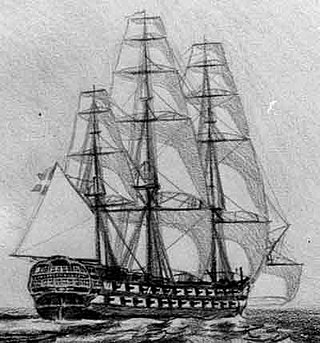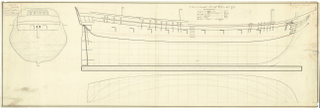
Holsteen was a 60-gun ship of the line in the Royal Dano-Norwegian Navy. She was commissioned in 1775 and the British Royal Navy captured her in the Battle at Copenhagen Roads on 2 April 1801. The British renamed the ship HMS Holstein, and later HMS Nassau. She participated in one major battle during the Gunboat War and was sold in 1814.
HMS Lively was a 32-gun fifth-rate Alcmene-class frigate of the British Royal Navy launched on 23 October 1794 at Northam. She took part in three actions – one a single-ship action, one a major battle, and one a cutting-out boat expedition – that would in 1847 qualify her crews for the issuance of the Naval General Service Medal. Lively was wrecked in 1798.
HMS Bold was a 14-gun Archer-class gun-brig of the Royal Navy built at Blackwall Yard. She took part in several minor actions and captured some prizes before she grounded in 1811 and was broken up shortly thereafter.

HMS Belette was an 18-gun Cruizer-class brig-sloop, built by King at Dover and launched on 21 March 1806. During the Napoleonic Wars she served with some success in the Baltic and the Caribbean. Belette was lost in the Kattegat in 1812 when she hit a rock off Læsø.

HMS Ferret was a Royal Navy Cruizer-class brig-sloop built by Benjamin Tanner at Dartmouth and launched in 1806, 19 months late. She served on the Jamaica, Halifax, and Leith stations during which time she took three privateers as prizes before she was wrecked in 1813.
HMS Crane was a Royal Navy Cuckoo-class schooner of four 12-pounder carronades and a crew of 20. She was built by Custance & Stone at Great Yarmouth and launched in 1806. Like many of her class and the related Ballahoo-class schooners, she succumbed to the perils of the sea relatively early in her career.
HMS Widgeon was a Royal Navy Cuckoo-class schooner built by William Wheaton at Brixham and launched in 1806. Like many of her class and the related Ballahoo-class schooners, she succumbed to the perils of the sea relatively early in her career.
HMS Sandfly was a Musquito-class floating battery of the Royal Navy. The two-vessel class was intended to defend the Îles Saint-Marcouf (Marcou) situated off the Normandy coast. During her brief career Sandfly shared in the capture of one privateer and participated in a battle that would earn her crew the Naval General Service Medal. The Peace of Amiens returned the islets to France in May 1802; Sandfly was paid off in June 1802 and broken up in 1803.

HMS Arab was the French 20-gun corvette Jean Bart, launched in 1793. The British captured her in 1795 and the Royal Navy took her into service. She was wrecked in 1796.

The Dutch brig Komeet was launched in 1789 at Amsterdam. HMS Unicorn captured her on the Irish station in 1795. The British Royal Navy took her into service as HMS Comeet; it renamed her HMS Penguin in 1798. It sold her in 1808.
Mutin was a 14-gun cutter of the French Navy, the lead ship of the Mutin class of five naval cutters. She was launched in 1778 and the Royal Navy captured her the next year, taking her into service as HMS Mutine. The Royal Navy renamed her HMS Pigmy in 1798. She was lost in 1805.

HMS Electra was a British Royal Navy 16-gun brig-sloop of the Seagull class launched on 23 January 1806. She was wrecked in 1808.

The French gun-vessel Eclair was one of 20 chasse-marées built in 1785 in southern Brittany for use as service craft in harbour construction at Cherbourg. In 1793 Martin or Jacques Fabien converted ten of them into chaloupes-canonnières (gun-vessels). One of these received the name Eclair. Sir Richard Strachan's squadron captured her in 1795 in Cartaret Bay, and the Royal Navy took her into service as HMS Eclair. She then sailed to the West Indies where she was probably out of service by 1801. In 1802 she was hulked under the name HMS Safety. She then served as a prison ship at Jamaica around 1808 to 1810. She may have been sold at Tortola in 1817/18, but in 1841 or so was brought back into service there as a receiving hulk. She was broken up in 1879.

Crachefeu was a French Navy gun brig launched in 1793. Sir Richard Strachan's squadron captured her in 1795 in Cartaret Bay, and the Royal Navy took her into service as HMS Crachefeu. She then sailed to the West Indies where she broken up in 1797, or possibly around 1802.
Brave, launched at Le Havre in 1793, was the name vessel of a two-vessel class of brig-rigged canonnières, i.e., gun-brigs. The French Navy renamed her Arrogante in May 1795. The Royal Navy captured her on 23 or 24 April 1798. The British Royal Navy took her into service as HMS Arrogante, but renamed her HMS Insolent some four months later. She was sold in June 1818.
HMS Rapid was an Archer-class gun-brig of 12 guns, launched in 1804. She took part in April 1808 in one action that in 1847 the Admiralty recognized with a clasp to the Naval General Service Medal. In May 1808 cannon fire from a shore battery sank her.
HMS Pultusk was the American-built French privateer sloop Austerlitz, which had been launched in 1805 and which the Royal Navy captured in 1807 and took into service as HMS Pultusk. Pultusk served in three campaigns, two of which resulted, some four decades later, in the award of medals, and one boat action that too received a medal. She was broken up in 1810.

HMS Vesuve was the French brick-cannonièreVésuve, name vessel of her class of seven bricks-cannonière. She was launched at Saint-Malo in 1793. The British Royal Navy captured her in 1795 and took her into service as HMS Vesuve. The Navy sold her in 1802.

HMS Eclipse was a French Navy Vésuve-class brick-canonnier or chaloupe-canonnière, (gunbrig) launched at Saint-Malo in 1793 as Volage. She was renamed Venteux in 1795 (possibly also Vérité on 30 May 1795, although this might have been a second ship of the same name. The British Royal Navy captured her in 1803 and took her into service as HMS Eagle, but then renamed her HMS Eclipse in 1804. She had a completely unremarkable career before the Navy sold her in 1807.
HMS Wasp was a 4-gun gun-vessel, formerly a Dutch hoy, purchased on 7 March 1794. She was fitted out at Woolwich between March and June 1794, and commissioned under Lieutenant George Hollwell. She was paid off in April 1795. Lieutenant John Wheatley recommissioned her in June. He paid her off in 1796. In September Lieutenant William Heppel recommissioned her. In February 1801 Lieutenant William Holmes replaced Heppel.








